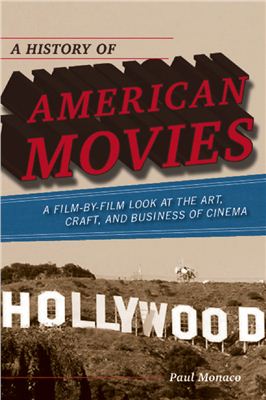The Scarecrow Press, 2010. - 368 pages.
A History of American Movies provides a survey of the narrative feature film from the 1920s to the present. The book focuses on 170 of the most highly regarded and recognized feature films selected by the Hollywood establishment: each Oscar winner for Best Picture, as well as those voted the greatest by members of the American Film Institute.
This book is for the reader who wants to understand one of the most important cultural institutions of the twentieth century: the American cinema. It is a history, but it is also a story. And telling any story requires selectively choosing what to put in and what to leave out. A History of American Movies chronicles an institution that had taken on its fundamental characteristics by
the year 1927, when the introduction of synchronous sound in film put an abrupt end to the silent movies. This story is about a professional community with its own ways of doing things, as well as a story about the relationships between the many talented people belonging to that community.
Cinema is simultaneously an art, a craft, and a business. Art is best defined as a human-produced object, text, or performance with limited practical utility but with added dimensions of meaning and value open to interpretation. A sunset may be beautiful and engage the viewer’s emotions, but it is not art. Like a sculpture, a coat rack may be a standing form made of wood and metal —but it is not a sculpture, and is not considered art. How art is regarded critically, and valued, is subject to complex development through cultural and social institutions, education, and the opinions of various experts.
A History of American Movies provides a survey of the narrative feature film from the 1920s to the present. The book focuses on 170 of the most highly regarded and recognized feature films selected by the Hollywood establishment: each Oscar winner for Best Picture, as well as those voted the greatest by members of the American Film Institute.
This book is for the reader who wants to understand one of the most important cultural institutions of the twentieth century: the American cinema. It is a history, but it is also a story. And telling any story requires selectively choosing what to put in and what to leave out. A History of American Movies chronicles an institution that had taken on its fundamental characteristics by
the year 1927, when the introduction of synchronous sound in film put an abrupt end to the silent movies. This story is about a professional community with its own ways of doing things, as well as a story about the relationships between the many talented people belonging to that community.
Cinema is simultaneously an art, a craft, and a business. Art is best defined as a human-produced object, text, or performance with limited practical utility but with added dimensions of meaning and value open to interpretation. A sunset may be beautiful and engage the viewer’s emotions, but it is not art. Like a sculpture, a coat rack may be a standing form made of wood and metal —but it is not a sculpture, and is not considered art. How art is regarded critically, and valued, is subject to complex development through cultural and social institutions, education, and the opinions of various experts.

